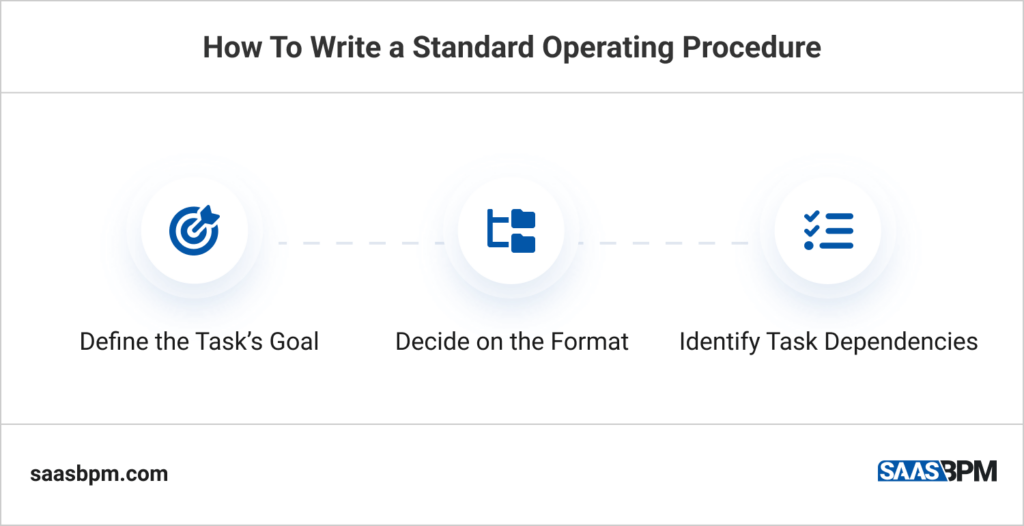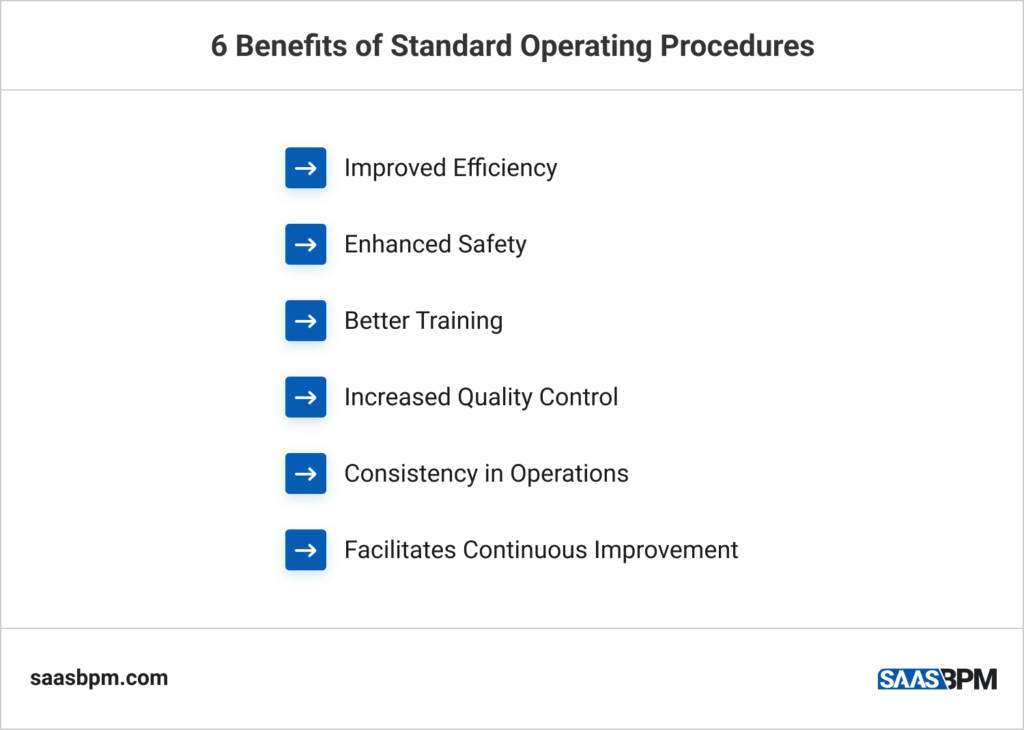In various industries and organizations, the implementation of Standard Operating Procedures (SOPs) plays a pivotal role in maintaining consistency, promoting efficiency, and ensuring safety.
SOPs act as comprehensive guides, providing a structured framework for routine operations. Consistency is achieved through clearly defined processes, reducing variations in task execution. Efficiency is heightened as SOPs serve as a roadmap, streamlining operations and minimizing time wastage.
Moreover, SOPs are integral to fostering a safe working environment by incorporating detailed safety protocols and guidelines. Across diverse sectors, from healthcare to manufacturing, SOPs serve as the linchpin for achieving operational excellence.
In this article, we will explore the critical role SOPs play in enhancing overall organizational performance, and their significance in achieving standardized, efficient, and secure processes.
What Are Standard Operating Procedures (SOPs)?
Standard Operating Procedures (SOPs) are comprehensive documents that serve as indispensable tools in organizational management. They act as detailed guides, providing step-by-step instructions for executing routine tasks within a specific framework. The primary purpose of SOPs is to establish a standardized approach to operations, ensuring consistency and reducing the likelihood of errors. By delineating the exact steps involved in a task, SOPs eliminate ambiguity and provide a clear roadmap for employees.
One of the key benefits of SOPs is their ability to significantly reduce errors in task execution. By offering a well-defined and consistent method for performing activities, SOPs minimize the risk of deviations from established procedures. This reduction in variability not only enhances the quality of output but also contributes to a more efficient workflow.
SOPs also play a crucial role in promoting best practices within an organization. By documenting the most effective and efficient methods for completing tasks, these procedures serve as a repository of institutional knowledge. This not only aids in training new employees but also facilitates continuous improvement. SOPs become living documents that can be updated to reflect evolving best practices, ensuring that organizations stay agile and responsive to changes in their operational environment.
How To Write a Standard Operating Procedure

To write an SOP properly, you need to make sure you clearly explain each step involved in a task, the task dependencies, and risks that could occur. It is important to format ir in a concise, comprehensive way. Also, in order to decide on the tasks and projects that need an SOP, you need to evaluate all your business processes closely and go through the following checklist:
- Who is involved in the activity?
- What are the responsibilities of each role?
- What is the desired goal of each role?
- Are all tasks required to achieve this result explained with detailed enough instructions?
Typically, there are three main steps to formulate an effective SOP:
Define the Task’s Goal
Why does this particular goal need an SOP? Outline the objectives and scope of the procedure. What is the specific task or process that needs documentation? Define the key inputs, processes, and expected outputs. Involve relevant stakeholders, including those who perform the task regularly, to gather insights and ensure comprehensive coverage. This step is crucial for laying the foundation of the SOP, establishing a clear understanding of the process’s intricacies.
Decide on the Format
Once you have defined the goal of the process and broken it down sequentially, you need to decide on the format that would be most optimal for your employees/everyone involved in its execution. The most popular formats for Standard Operating Procedures are flowchart, diagram, or a bulleted/ numbered list of the main steps in hierarchical order.
Identify Task Dependencies
Identifying task dependencies is a crucial step in project management as it helps ensure that tasks are executed in the right sequence and that the project progresses smoothly. When preparing an SOP, you should first see if the process at hand is intertwined with any other procedures that you need to take into consideration.
Why is it important to follow SOPs at all times?
Consistent adherence to Standard Operating Procedures is paramount for several compelling reasons. Firstly, SOPs promote standardization, establishing uniformity in the execution of tasks across an organization. This consistency not only enhances operational efficiency but also contributes to the predictability of outcomes.
Secondly, following SOPs reduces risks associated with human error and deviations from established procedures. By providing a structured and standardized approach, SOPs mitigate the likelihood of mistakes, ensuring a smoother workflow and minimizing potential disruptions.
Moreover, SOPs play a pivotal role in ensuring compliance with regulations and industry standards. Organizations operating within regulated environments must adhere to specific guidelines to maintain legal and ethical integrity. SOPs serve as a tangible framework, aligning operations with these regulations and ensuring that every aspect of a task is performed in accordance with stipulated standards.
In essence, the importance of following SOPs consistently lies in their ability to foster standardization, reduce risks, and uphold regulatory compliance, ultimately contributing to the overall success and integrity of an organization.
6 Benefits of an SOP: Unlocking Operational Excellence

Standard Operating Procedures (SOPs) stand as the linchpin for achieving operational excellence in diverse industries. Their significance extends far beyond mere documentation; SOPs are dynamic tools that confer a multitude of benefits, shaping efficient, safe, and quality-focused organizational practices.
1. Improved Efficiency
SOPs streamline operations, providing a systematic guide that minimizes ambiguity and reduces the time spent on routine tasks. By offering a standardized approach, employees can navigate through processes seamlessly, enhancing overall workflow efficiency. This efficiency not only accelerates task completion but also contributes to resource optimization, enabling organizations to achieve more with fewer resources.
2. Enhanced Safety
A paramount benefit of SOPs is the enhancement of workplace safety. By incorporating detailed safety protocols, these procedures mitigate risks associated with task execution. Whether in manufacturing, healthcare, or any other industry, adherence to SOPs ensures that employees are well-informed about potential hazards and the appropriate measures to mitigate them. This proactive approach not only safeguards personnel but also protects organizational assets.
3. Better Training
Standard operating procedures serve as invaluable training resources, especially for new hires. The step-by-step instructions outlined in these documents provide a structured learning path, easing the onboarding process. New employees can quickly grasp the intricacies of their roles, leading to a faster integration into the workforce. Additionally, SOPs contribute to a consistent training methodology, ensuring that every employee is equipped with the same foundational knowledge.
4. Increased Quality Control
Maintaining consistent product or service quality is a critical aspect of organizational success. SOPs play a pivotal role in this by providing a standardized framework for task execution. Through systematic checks and controls at each stage of a process, organizations can uphold predetermined quality standards. This commitment to quality control not only satisfies customer expectations but also enhances the reputation and competitiveness of the organization.
5. Consistency in Operations
SOPs contribute to the establishment of uniformity in how tasks are executed. This consistency is crucial, especially in industries where precision is paramount. Regardless of personnel changes, adherence to SOPs ensures that processes remain unchanged, leading to predictable and reliable outcomes. This is particularly vital in sectors such as pharmaceuticals, where adherence to specific protocols is essential for regulatory compliance.
6. Facilitates Continuous Improvement
SOPs are not static documents; they are living tools that adapt to the evolving needs of organizations. Regular reviews and updates enable organizations to assess the efficacy of existing processes and implement improvements. This commitment to continuous improvement ensures that SOPs remain relevant and effective, aligning with the changing dynamics of the business environment.
Final Thoughts
In essence, Standard Operating Procedures emerge as indispensable tools, weaving a fabric of consistency, efficiency, and safety within organizations. Beyond being mere guidelines, SOPs embody the key to operational excellence. Their benefits, ranging from improved efficiency and enhanced safety to streamlined training and increased quality control, showcase their pivotal role in shaping successful organizational practices. By fostering a culture of adherence to standardized processes, SOPs become catalysts for continuous improvement, ensuring organizations not only meet industry standards but also thrive in an environment of precision and reliability, ultimately contributing to sustained success in today’s competitive landscape.


